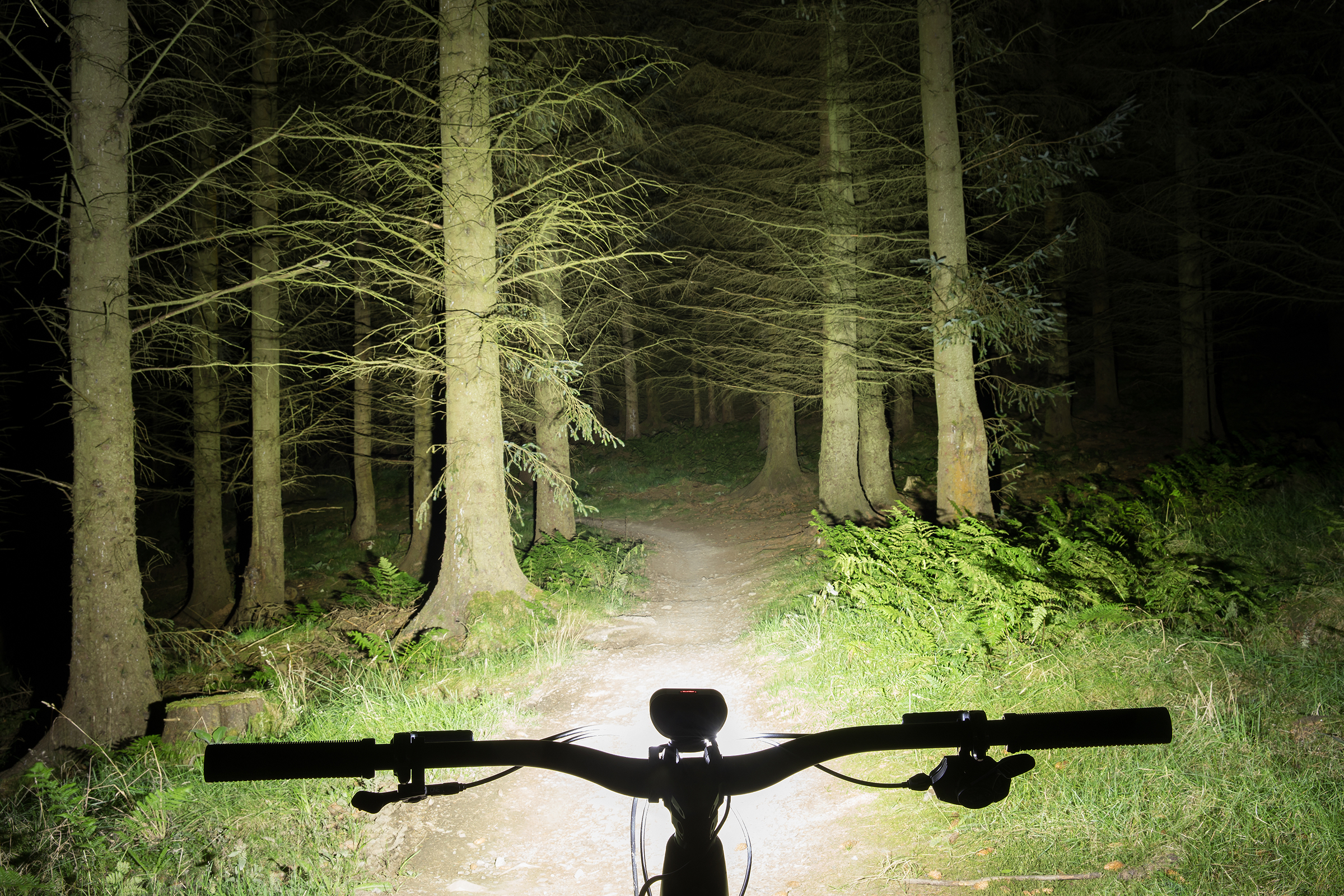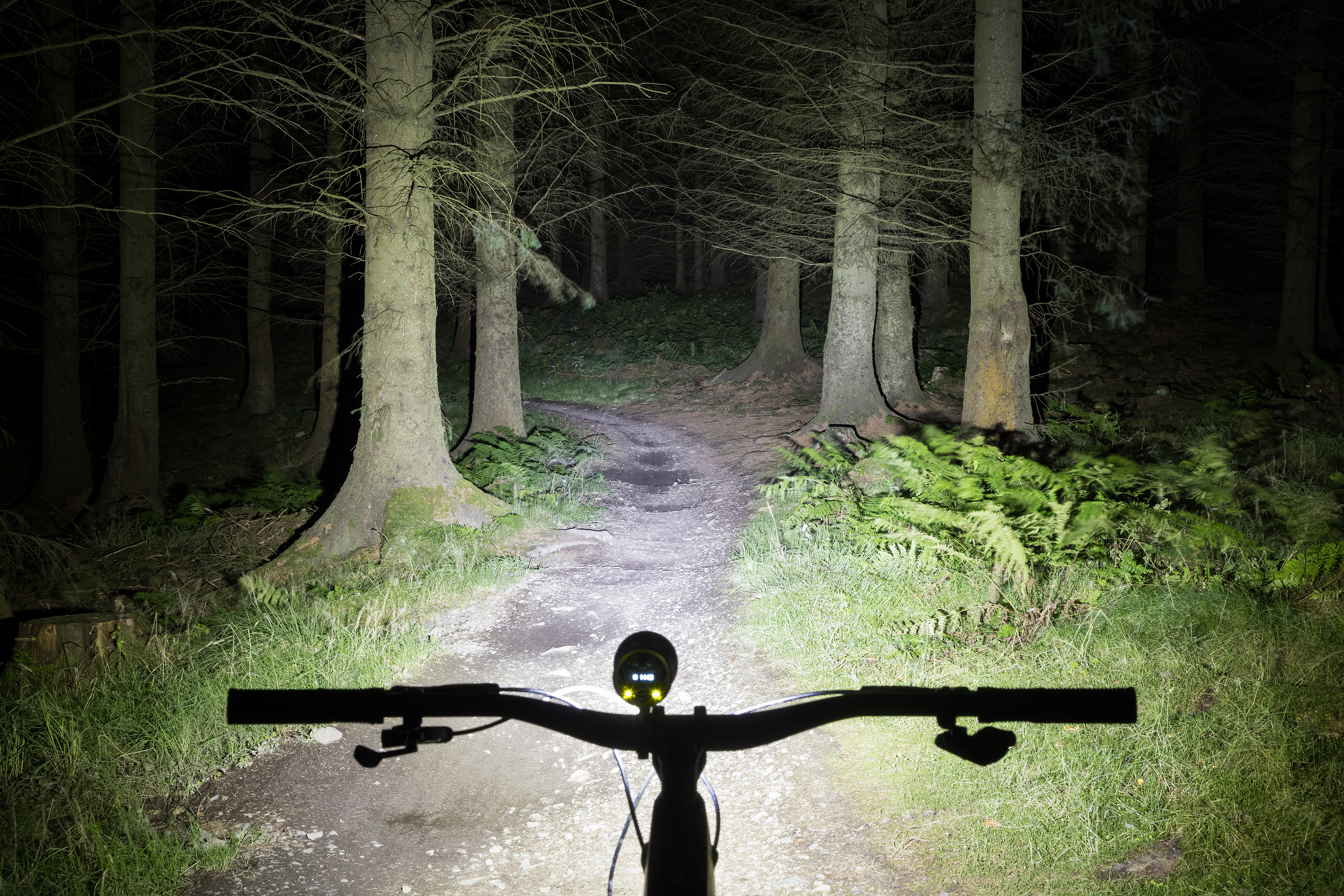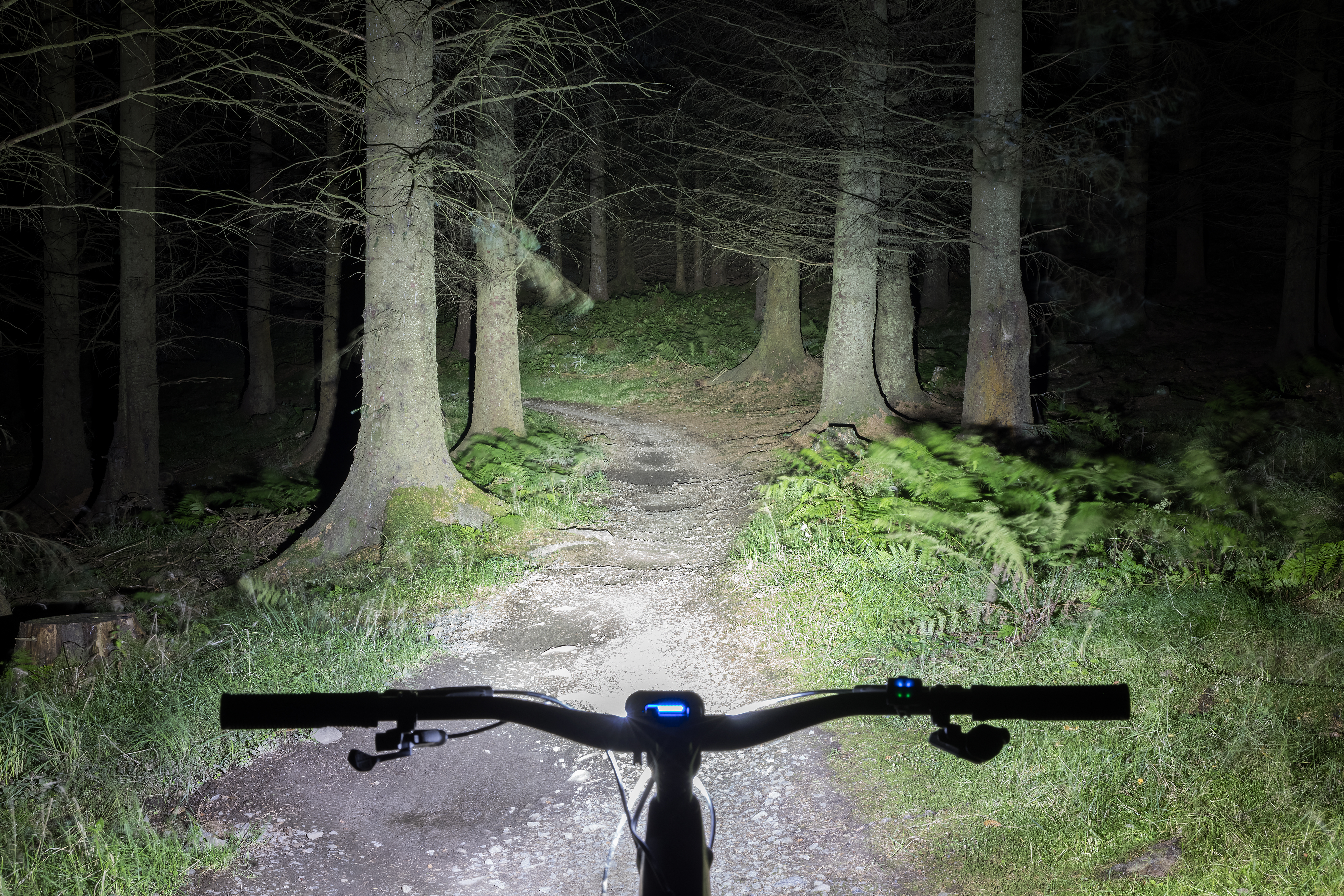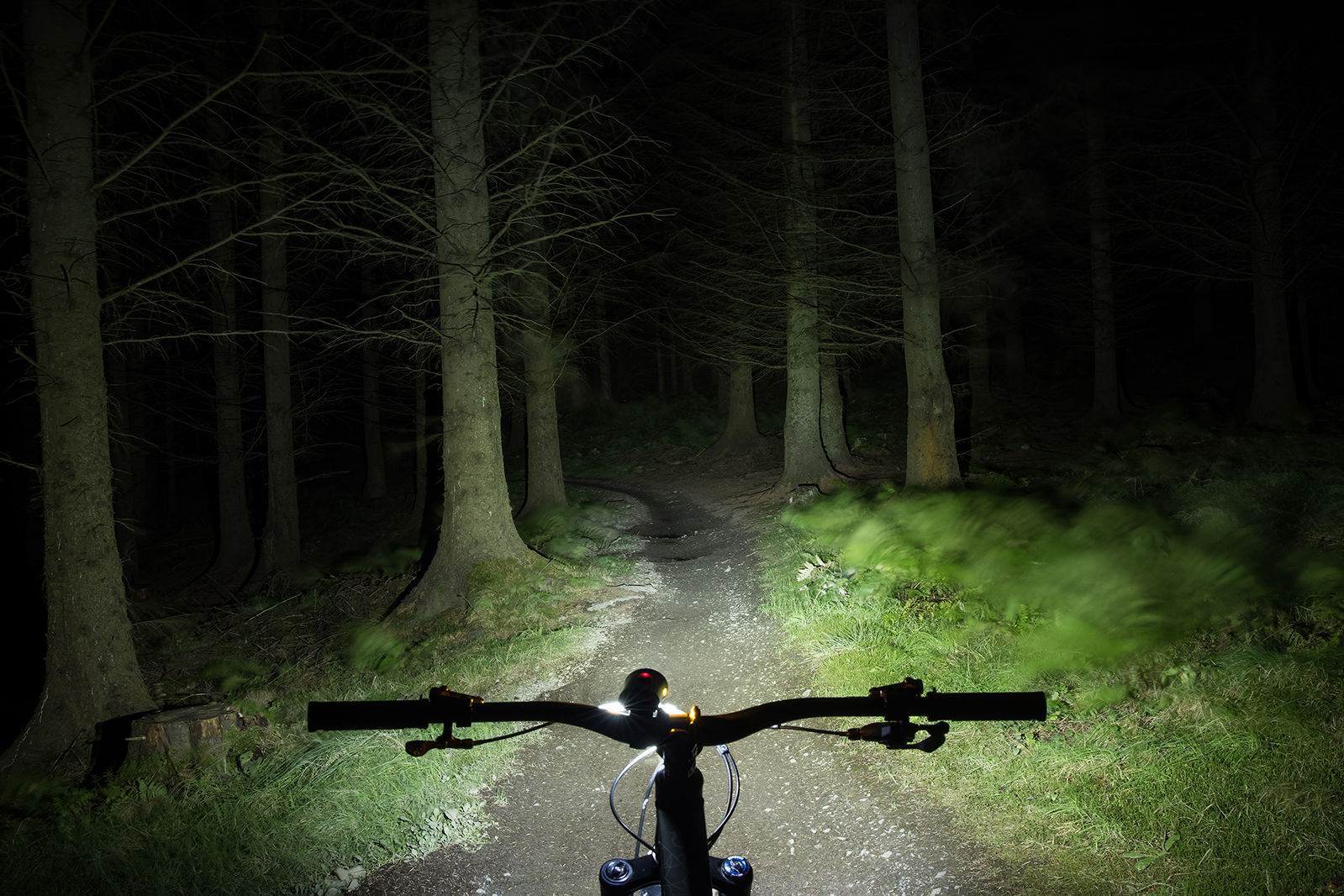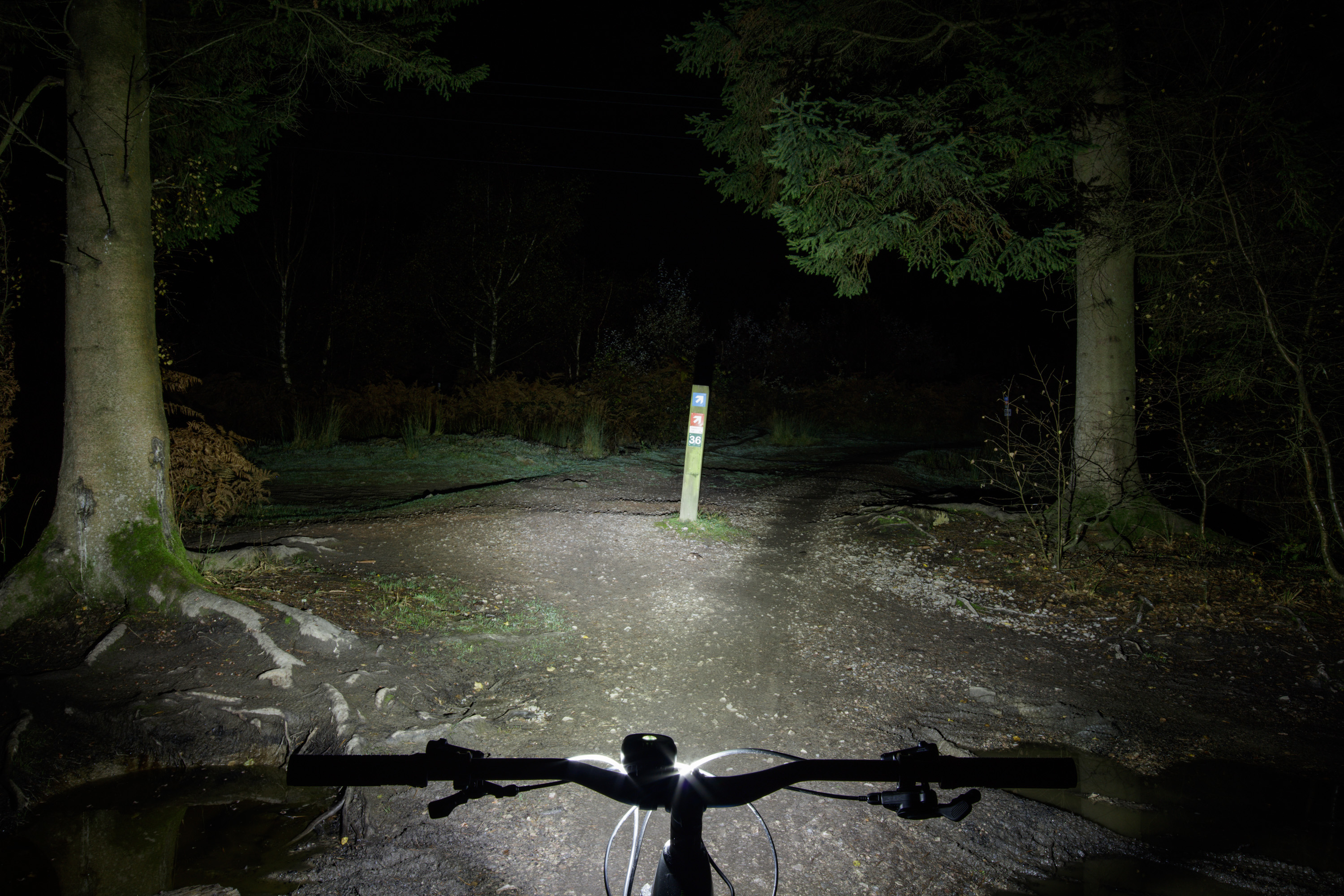If you’ve never been mountain biking at night before, you’re missing out. It presents an awesome challenge; obstacles come at you faster, it feels like you’re riding at warp speed and there’s something majestic about the woods at night.
You’ll need a high-powered front light to illuminate the trail, though, and these are the best mountain bike lights as tried and tested by the BikeRadar team.
The brighter your lights are, the better your night riding experience is going to be. You’ll be able to see more of the trail, obstacles shrouded in the shadows pop out at you and speed comes naturally.
In this guide, we’ve focused on high-powered lights for mountain biking. Otherwise, check out our guide to the best bike lights for road cycling and commuting.
If you’re looking for more detail about what to look for when buying a mountain bike light, you can skip to our buyer’s guide at the end of this article.
Best mountain bike lights 2024, as rated by our expert testers
Exposure MaXx-D MK15
- Price: £450 / $550 / €530 as tested
- Claimed max output: 4,600 lumens
- Run time (max power): 2 hour
- Pros: Incredible beam hue; good beam pattern; sturdy construction
- Cons: Cost
Class-leading illumination, top-quality construction and clever tech make this all-in-one light well worth its high price tag.
The Reflex mode senses movement, adjusting power output to the difficulty of the trail. Stop riding, or cruise along a smooth section of trail, and the light dims slowly so your eyes can adjust.
Wiggle the bar or hit a bump and it switches to full power instantly. This works so well it renders manual modes pointless, so you can have an entirely hands-off experience.
There’s more than enough power to light up the most technical trails and it’s evenly spread with a gradual fade that provides incredible context. Plenty of light is projected downwards which also has beautiful hue.
In 2,700-lumen Reflex mode, run time is a generous three hours. The aluminium unit is IP65-rated and has a two-year warranty; the LEDs are guaranteed for life.
Magicshine Monteer 8000S Galaxy V2.0
- Buy direct from Magicshine

- Price: £340 / $410 as tested
- Claimed max output: 8,000 lumens
- Run time (max power): 1 hour 38 minutes
- Pros: Immense power for technical trail riding
- Cons: Run time; battery and mode indicators would be a great bonus
Boasting a brain-bending 8,000 lumens, the Galaxy’s immense brightness is second to none. It lights up the trail and its surroundings with fantastic competence, making it a one-stop-shop for gnarly trail riding.
Magicshine has updated this light over the original with the addition of software and hardware needed for the Bluetooth wireless remote control.
There are 30 modes, with claimed run times starting at 32 hours for the 400-lumen setting and dropping to one hour 30 minutes for the 8,000-lumen max-power mode, although it ran for slightly longer in testing.
There are no bleached spots of light on the trails and the impressive beam pattern is broad and well-controlled.
The addition of a mode or battery indicator would be an area for the brand to explore in a future iteration, otherwise it’s top marks.
The V2.0’s predecessor, the MagicShine Monteer 8000S Galaxy, also scored a full five stars last year and is worth consideration.
Magicshine Monteer 12000

- Price: £450 / $550 / €530 as tested
- Claimed max output: 12,000 lumens
- Run time (max power): 2 hours 30 minutes
- Pros: Massive beam spread; immense power; easy to use
- Cons: Bar mount width
With unrivalled power and a massive beam spread, the Monteer 12000 has the ability to turn night into day.
It lives up to Magicshine’s claims, pumping out an incredible amount of well-distributed light for brilliant trail context that boosts rider confidence sky-high.
Its throw is immense, and in flood mode it illuminates the sides of the trail and around corners, too, in a soft hue that’s easy on the eyes.
Over two hours is a superb run time for 12,000 lumens and lower modes extend battery life considerably while still projecting ample light.
The head unit and hefty 900g battery are impact-resistant and IPX6-rated, while the sturdy twin-clamp mount offers tool-free angle adjustment. A lid mount is included, too. There are charge indicators on the light, battery and Bluetooth remote.
Exposure Six Pack MK12

- Price: £445 / $610 / €535 as tested
- Claimed max output: 5,250 lumens
- Run time (max power): 2 hours 4 mins
- Pros: Good forward illumination; Clever automatic Reflex mode
- Cons: Beam could be wider
With six XPL2 LEDs and 24 modes in total, the Exposure Six Pack is an impressive beast, reflected in its 406g weight. Exposure’s clamp screws to the bars to keep it stable.
The in-built Reflex technology uses accelerometers to calculate how fast you’re travelling and how rough the terrain is, and increases or decreases brightness to match, up to 5,250 lumens, so you don’t need to fiddle with the controls as you ride. You’re limited to 3,750 lumens in the highest constant mode though.
It casts a wider spread of light down the trail than its MK11 predecessor and the LED’s hue is beautiful. Being very fussy, the beam’s spread could be wider closer to its source.
We also highly rated the Exposure Six Pack MK11, the MK12’s predecessor, which is also well worth considering.
Gemini Titan 4000

- Price: £350 / $350 / AU$450 as tested
- Claimed max output: 4,000 lumens
- Run time (max power): 2 hours 25 minutes
- Pros: Very impressive brightness; long run time
- Cons: Limited beam spread; expensive
The Gemini Titan claims to output a very respectable 4,000 lumens, and while we didn’t specifically confirm the claim, we can confirm that its output in the real world is enormous – with our tester finding it could “turn night into day”.
Furthermore, it has a phenomenal run time at around two and a half hours for such a powerful light.
It misses out on a five-star rating because it’s pretty expensive and the beam spread isn’t quite perfect, but if you need this sort of power you’ll be very impressed.
Gloworm XS Adventure Lightset (2.0)

- Price: £245/ $309 / AU$410 as tested
- Claimed max output: 2,800 lumens
- Run time (max power): 1 hour 50 minutes
- Pros: Customisable optics and output; remote makes for easy mode changes
- Cons: Battery display is hard to read on the move
You can customise the optics of the Gloworm’s three LEDs by replacing the lenses, with spot, honeycomb and wide angle options and there’s a smartphone app, so you can fine-tune the light to match your riding. Two different battery cable lengths cater for bar or helmet mounting of the light unit. You get a wireless remote too and you can buy yet more lens options.
The bar mount provides a stable beam and is easy to hook up to the bars, while the battery pack secures firmly to the frame with two velcro straps. The remote makes changing modes simple, although its two buttons aren’t illuminated.
With the optics swapped out, there was a good spread of light to help pick out turns and a good throw of light down the trail with plenty of illumination, so you shouldn’t need a second light source.
Lupine Alpha

- Price: €1,080 as tested
- Claimed max output: 7,200 lumens
- Run time (max power): 1 hour 20 mins
- Pros: High power output
- Cons: Mount stability; cost
Although its power comes at a price, the Lupine Alpha seriously impressed. Its maximum 7,200-lumen output is as powerful as it sounds, and it has a super-focused centralised spot, meaning no obstacle goes unseen.
It’s an easy light to use, with five default modes and an additional three that can be accessed. Our only gripe is the unit tended to shift closer to the ground on rougher terrain.
Magicshine Monteer 6500

- Price: £226 / $350 as tested
- Claimed max output: 6,500 lumens
- Run time (max power): 2 hours 20 minutes
- Pros: Exceptional spread of light; illuminating LED colour
- Cons: Cost; no battery life display or mode indicator
With five LED lights and a whopping 6,500 lumens total claimed output, the Magicshine Monteer 6500 is a seriously capable unit.
At maximum 5,000 and 4,000 lumens modes it’s an astonishingly powerful light, but we were also impressed by how this power is put to use. The two spot LEDs illuminate the trail ahead brilliantly, while the three flood LEDs provide unrivalled side-to-side and forward visibility.
Battery life is also excellent; 2 hours 20 minutes run time at full whack is amazing, and this exceeds the claimed life by over an hour, which we really appreciate.
Its downsides include its relatively high price and a lack of a battery life display or mode indicator – problematic when there are 15 modes – but these issues fade away very quickly when in use.
Niterider Lumina Dual 1800

- Price: £160 / $149 as tested
- Claimed max output: 1,800 lumens
- Run time (max power): 1 hour
- Pros: Great beam spread; impressive power output
- Cons: Limited run-time on max power
The Niterider Lumina Dual 1800 is a top-performing light that took us a bit by surprise. Despite its relatively low claimed max lumens, it has great power and beam spread, and it’s also relatively cheap, so ticks a lot of boxes.
The internal battery is quite small, so you only get an hour’s run time at full power. It’s not the most sophisticated looking light we’ve tested either, but it easily outperforms its price tag and competes with many of the more expensive lights we’ve tested.
Blackburn Countdown 1600

- Price: £159.99 / $170 as tested
- Claimed max output: 1,600 lumens
- Run time (max power): 1 hour 18 minutes
- Pros: Easy to use; good beam colour; plenty of power
- Cons: Beam spread limiting
Feeling much brighter than its claimed 1,600 lumens in Blitz mode and boasting an excellent IP67 rating, this is a great little all-in-one light.
It’s powerful enough for most black-graded trail centre runs and the beam’s white hue with brown/red highlights illuminates trail surfaces well adding good depth.
The light has a long throw, making it easy to reach high speeds on straighter trails. Introduce tight switchbacks, however, and the lack of spread and stark peripheral cut-off limit speed and confidence.
While the interface between light and mount is good, the plastic clamp is hard to tighten, although its narrow width does leave space on the bar.
Gloworm XSV

- Price: £289 / $320 / AU$389 as tested
- Claimed max output: 3,400 lumens
- Run time (max power): 1 hour 50 minutes
- Pros: Long battery life; good mix of flood and spot lighting
- Cons: Standard beam is quite focused
With a great amount of power and plenty of range, the Gloworm XSV impressed us with its ability to highlight the trails as if it were daytime.
The spot is fairly focused on the front of the bike, but its good power output means beam spread is okay (though not amazing) with the standard lenses installed. Run time is also good at 1 hour 50 minutes on full power.
Unlike a lot of other lights, it comes with a range of accessories, making the hefty price tag a bit more palatable. The fact that it can also be linked into a system with other Gloworm lights makes it a very attractive option for anyone interested in the ecosystem as a whole.
Gloworm X2 (G2.0)

- Price: £270 / $307 / €315 / AU$377 as tested
- Claimed max output: 2,000 lumens
- Run time (max power): 4 hours
- Pros: Customisable lenses; lightweight; easy to use
- Cons: Beam spread limited; could be brighter
Another well-made light, the IP67-rated X2 comes with three spare lenses to tune the beam pattern, plus you can customise its modes via an app.
Despite the head unit’s diminutive size, the beam’s gentle green hue is well-balanced between spot and flood, giving a long throw down the trail.
It punches above its 2,000-lumen output, too, with ample power to tackle technical terrain. Although the peripheral beam cut-off is gradual, the spread could be wider for spotting lines in tight turns.
Swapping in the alternative lenses resulted in a dimmer beam, so we stuck with the stock set-up.
The limited spread makes the X2 better suited to helmet use (Velcro and GoPro-style mounts are included).
Operation is simple using the wireless remote, and its three-hour burn time on max power is impressive. The out-front clamp frees up bar space.
Hope R4 LED Std
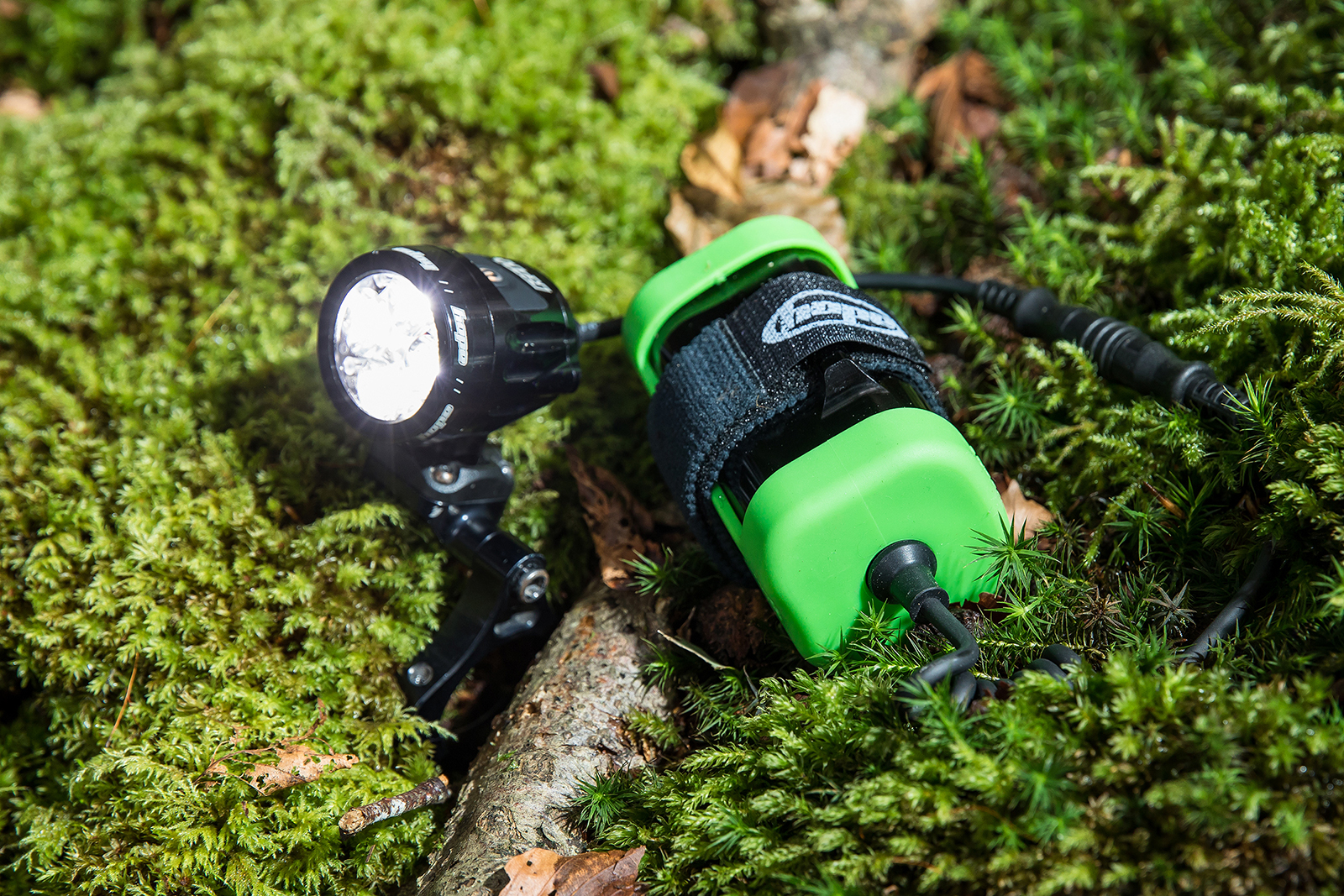
- Price: £230 / €285 as tested
- Claimed max output: 2,000 lumens
- Run time (max power): 2 hours 30 minutes
- Pros: Long-range illumination
- Cons: Sensitive heat management
Hope’s R4 uses four LEDs that form a cross pattern. Power is impressive and it feels as though you’re getting the full claimed 2,000 lumens.
It’s bright enough to highlight rocks and roots far off into the distance in front of you. However, although the fade-off is very gradual, there isn’t quite enough spread and power to illuminate the margins of the trail as much as we’d like.
The head unit has a single power button/mode selector that changes colour to indicate which of its six settings it’s in. The separate 6,200mAh, four-cell battery pack – the larger of two options available with the R4 – has a traffic light battery indicator.
Our test unit’s thermal throttling was quite sensitive, and after two minutes of being stationary with the light on max power in 14°C temperatures, it reduced output to the middle setting.
Hope R8

- Price: £289 as tested
- Claimed max output: 4,000 lumens
- Run time (max power): 1 hour 25 minutes
- Pros: Exceptional illumination; easy to use
- Cons: Issues with long-term robustness
It’s not the most powerful light we’ve ever tested, but the Hope R8 puts out enough light to illuminate everything in front of you and then some. Side-to-side flooding is very good too, and is in fact wide enough to spot lines even when it’s not pointing directly where you want to go.
It’s very easy to use and the battery life is solid, if not exceptional, at 1 hour 25 minutes on full power. The low-power mode caught us by surprise on occasion, though – once the battery goes under 30 per cent charge it’s no longer possible to select a higher-power mode from a lower one.
We also had concerns about the long-term durability of the mount, but Hope’s after-sales support is generally very well regarded.
LifeLine Pavo Motion 3500
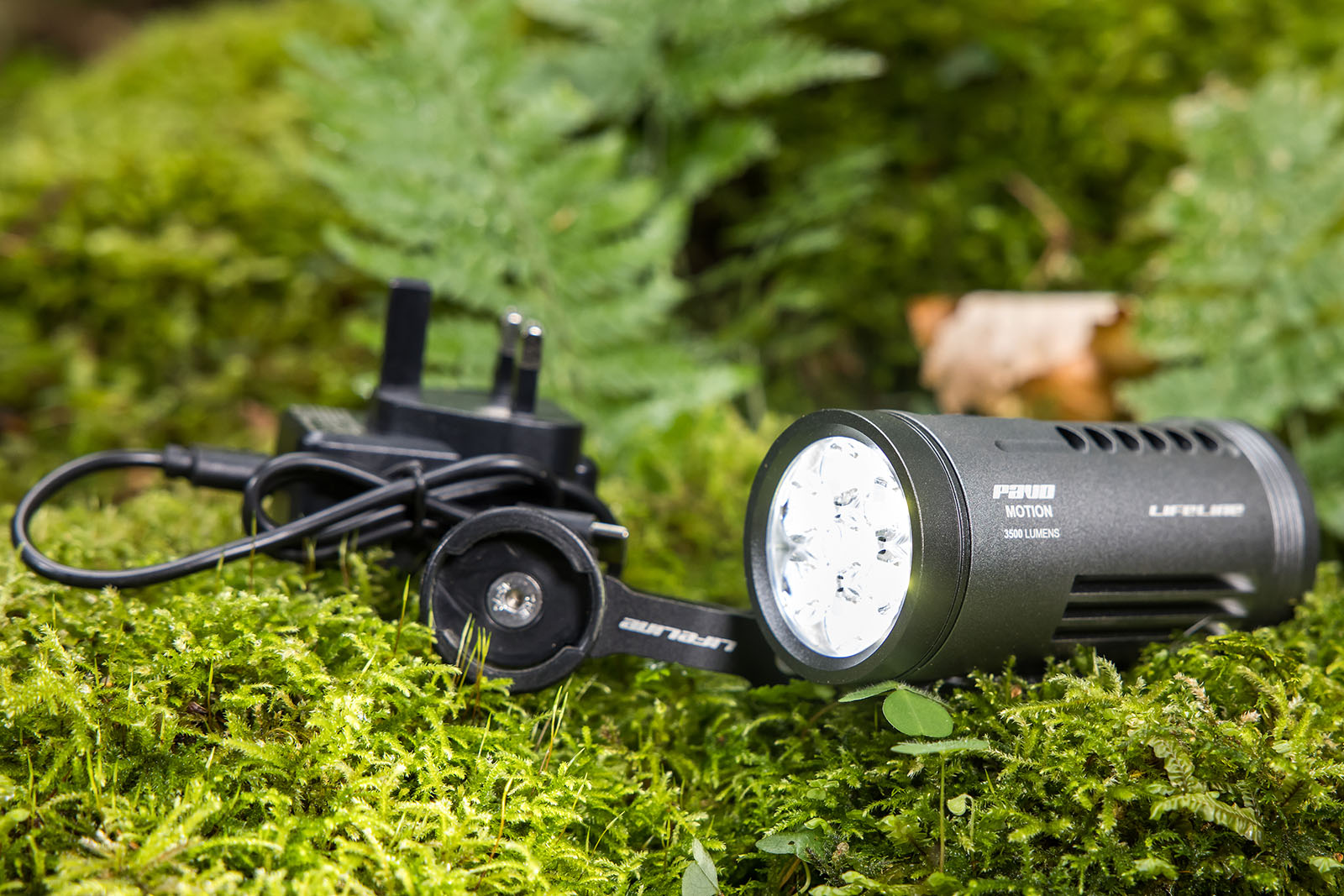
- Price: £170 / $220 / €200 / AU$300 as tested
- Claimed max output: 3,500 lumens
- Run time (max power): 2 hour 30 minutes
- Pros: Good beam spread; Motion mode works well
- Cons: Battery feels smaller than claims; beam could be more powerful
With features similar to far pricier competitors, the Pavo is a great all-in-one light, without the inconvenience of an external battery or cables.
The twist-lock mount is stable and the beam lights up obstacles and lines way ahead, but the peripheral fade is gradual, which helps provide context on the trail.
While power feels lower than claimed, it’s ample to ride gnarly trails with confidence, although a better beam spread would be helpful in tight turns.
The yellow/brown hue highlights earthy tones well. LifeLine’s Motion technology adapts the light’s output depending on movement, halving it when you’re stationary.
This works well and is refined enough to negate switching modes on the fly. The on-off/mode button doubles as a low-battery indicator by switching colours. While mode selection is intuitive, the colour system can be confusing.
Light & Motion Seca Comp 2000

- Price: £255 / $225 as tested
- Claimed max output: 2,000 lumens
- Run time (max power): 1 hour 20 minutes
- Pros: Good colour balance to avoid dazzle; great for non-technical riding
- Cons: Bar mount isn’t very secure; power is too weak to benefit from its wide-angle optics
A smaller, lighter unit than many, the Light & Motion Seca Comp 2000 is controlled by two buttons, with the main one illuminated and the second operating orange sidelights for on-road use.
Light colour balance is good, with the green and yellow hues avoiding dazzle. We found the mount didn’t hold the light quite securely enough though, so there was a tendency for the beam to drop down. There’s a GoPro-style mount included that should eliminate this.
We reckoned that the Seca Comp gave more light than its stated output, although there wasn’t quite enough to cope with all the trail features we encountered, due to the broad beam spread. It’s a good option for less technical routes and casual night riding though.
Light & Motion Seca Enduro

- Price: £350 / $400 as tested
- Claimed max output: 2,500 lumens
- Run time (max power): 2 hour 40 minutes
- Pros: Well-managed light output with good beam spread; long run times on max power
- Cons: Battery and mode indicators not the easiest to use; expensive
Out on the trail, the Light & Motion Seca Enduro feels like it puts out a lot more than its claimed 2,500 lumens max power, showing that raw power numbers don’t always tell the whole story with lights.
Much of this is down to how the power is used. The optics create a fantastic mix of flood and spot lighting, and side-to-side lighting is also great. The only drawback from its lack of pure horsepower is that the range isn’t amazing, but this is only a real problem when you’re going at top speed on fast fireroad descents.
Battery life is impressive and although the mode and battery indicators are a bit vague it’s an easy-to-use unit overall. The big problem, however, is the price. It’s an expensive light and at this price point you might fancy a little more power.
Lumicycle Apogee Carbon Extender Pack

- Price: £366 / €400 / $395 / AU$550 as tested
- Claimed max output: 4,500 lumens
- Run time (max power): 1 hour 50 minutes
- Pros: Impressive beam spread; good colour balance
- Cons: Difficult to decipher functionality
Lumicycle drafted in an ex-Formula 1 thermal and aerodynamic engineer to work on the 2021 Apogee, with a focus on improving efficiency and reducing weight.
It still has the optics from last year, for a seriously impressive beam spread, even with the standard 19-degree beam pattern. If you want an even wider spread, you can order a 26-degree flood optic.
There are four LEDs that deliver a fantastic mix of white and green light, making everything stand out, helped by its massive 4,500-lumen output. But we feel the Apogee could still do with a bit of an illumination boost outside the spotlight’s strong focal point.
The 6,800mAh, Panasonic-celled battery pack boasts a carbon fibre shell with rubber ends. It’s fixed with the Velcro straps but sits quite proud of the frame, reducing potential mounting points.
Magicshine MJ-906S

- Price: £140 / $200 as tested
- Claimed max output: 4,500 lumens
- Run time (max power): 3 hours 26 minute
- Pros: Long run time and plenty of power; good option for a helmet light
- Cons: Not the best on tight trails; buttons not the easiest to use
A separate battery pack, paired with a small head unit, gives the Magicshine a small profile on the bars, while the quarter-turn mount keeps lighting stable over rough ground. There’s also a cable to hook up to an electric bike and skip the light’s battery.
There’s plenty of power on offer from the two LEDs (plus a daytime running light strip), which can be operated independently. We were impressed with the run time, although switching between modes was a bit tricky, as the top button isn’t illuminated.
There’s a good spread to the beam pattern and different coloured near and far illumination to help pick out obstacles, although we found the central spot a bit too bright relative to the periphery. We reckon it would make a great helmet light though.
Moon Rigel Enduro

- Price: £190 / $261 / AU$342 as tested
- Claimed max output: 2,600 lumens
- Run time (max power): 2 hours 3 minutes
- Pros: Eight modes plus variable output and boost
- Cons: Unintuitive mode selection
With 2,600 lumens peak output, a 9,000mAh battery and a wired remote, along with an LED display of mode and battery life, the Moon Rigel provides plenty of illumination from its six LEDs. It has an out-front mount to push it ahead of the bars.
There’s an ambient light sensor that puts the light in standby mode during the day so you don’t burn through the battery while it’s still light, and you can choose to vary output continuously rather than via the eight set modes.
The LEDs give a mix of spotlight and wide-angle side illumination that’s good for a wide variety of trails. Using the light isn’t intuitive though and we had to study the manual before we could get riding.
Moon Rigel Power

- Price: £260 / $230 as tested
- Claimed max output: 3,600 lumens
- Run time (max power): 1 hour 56 mins
- Pros: Excellent beam colour; stable mount
- Cons: Mode selection and indication hard to understand; battery life display unintuitive
Powered by six LEDs, Moon’s Rigel Power features three different programs, each with eight modes. The light has an intelligent function, where the unit can change its brightness, depending on the ambient light.
The Rigel Power’s lighting is well distributed and its 3,600-lumens maximum output provides enough light for high levels of detail without bleaching the trail’s colours. This is particularly impressive, given the unit’s small size.
A more intuitive method of selecting modes and the addition of a battery life display are the only factors that stop this light scoring higher.
Moon X-Power 1800

- Price: £220 / $270 as tested
- Claimed max output: 1,800 lumens
- Run time (max power): 1 hour 50 minutes
- Pros: Good mix of focused and side illumination; works well as a helmet light
- Cons: A little low on power considering aptitude of beam
The X-Power 1800’s CNC-machined, black-anodised and polished head unit houses four LEDs that look like they put out more light than Moon’s quoted 1,800 lumens. This makes it suitable for riding pretty much all trail centre-type routes and gentler singletrack too.
The beam pattern gives a bright and fairly round focal point, and some side and front flood tapering that helps generate context on the trail. However, the reach of the light is lacking a little.
Included in the box is a helmet mount, and we think the X-Power works best as a lid light. It has four steady and two flashing modes, plus an SOS mode.
The 5,200mAh battery pack is quite long at 17cm, so can be tricky to mount on bikes with curvy tubes. Also, the battery indicator is bright to the point of being distracting when the battery is mounted on the top tube.
Ravemen PR1600

- Price: £130 as tested
- Claimed max output: 1,600 lumens
- Run time (max power): 1 hour 35 minutes
- Pros: Enough power to get you out on the trails; well priced
- Cons: Limited beam spread
For the price, the Ravemen PR1600 is an incredible light. At a claimed 1,600 lumens, it’s far from the brightest light we’ve tested, but it will get you out on the trails with no fuss at all and at a very decent price.
The compromise is that while the PR1600 has good range, and the flood illuminates the distance ahead well, it can’t match its pricier, multi-LED competitors for beam spread.
It’s certainly good enough as a starting point, just perhaps not for properly technical and fast downhill tracks. It would also make a great option for people who do a mix of off-road and on-road riding.
Ravemen PR2400

- Price: £255 as tested
- Claimed max output: 2,400
- Run time (max power): 1 hour 30 minutes
- Pros: Different high and low beam patterns; good beam power
- Cons: Large dimensions takes up space on the bar
The Ravemen comes with a wireless remote and an external power pack, so you can boost its 1.5-hour run time. The light includes a display of which of the eight modes is in operation and the remaining run time, as well as whether a high or low beam is in use.
High and low beams have different patterns, with the high beam focusing light in the distance and the low beam flooding the closer area. We were impressed with the ability to highlight trail features, while the yellow/green hue avoids the harshness of blue or white LEDs.
Although lower powered than many of the alternatives, there’s a good beam spread and gradual fade that help on switchbacks. But higher speeds on tight trails did test the illumination on offer.
Mountain bike lights buyer’s guide
What to look for in a mountain bike light
When considering which mountain bike light to buy, there are four things worth bearing in mind:
- Lumens
- Run time
- Beam pattern
- Extras
A minimum of 1,500 lumens will provide enough light for well-lit riding. You can get away with less, but if you ride fast or on technical trails more lumens is better than less.
Run time can vary a great deal between lights and it is minimised the more power the LEDs are pumping out. We’ve listed the run time for each of the lights in this list at max power.
Beam pattern refers to how the lights disperse light across the trail, and it can be just as important as lumens when it comes to how well you can see.
Lights will often have either a spot or flood pattern. Spot patterns highlight details in front of you in great detail. Flood patterns disperse the light over a wider area and can give you a better sense of what’s around you. Some lights use a mixture of both.
Do you need an extra-long cable for a battery pack? Are you looking to mount a light on multiple bikes It’s worth paying attention to the extras that come with a light to make sure it is suitable for your specific needs.
We’ve made sure to refer to these four points in the reviews of all the lights listed here.
Lumens
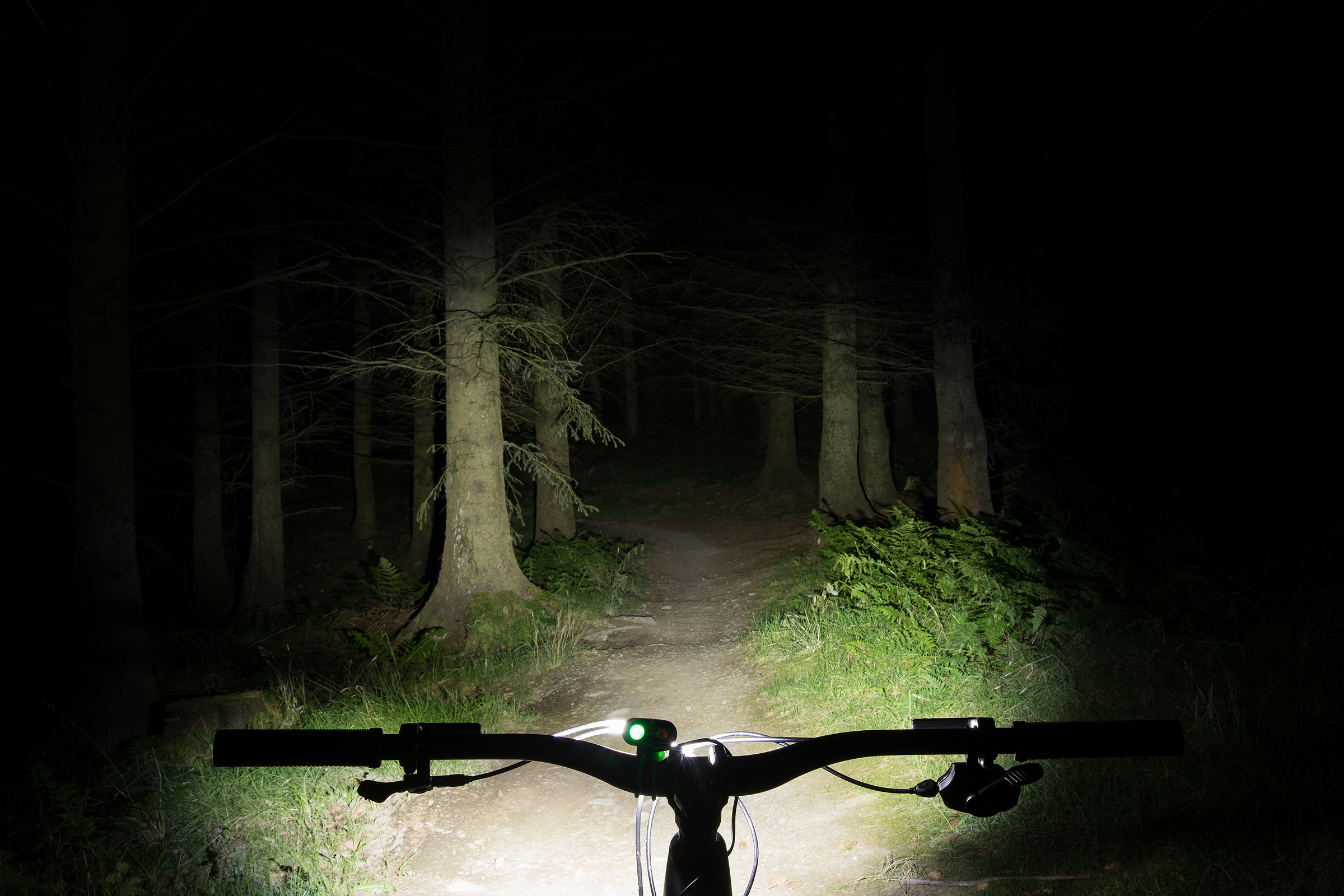
We set a lower limit of 1,500 claimed lumens when testing mountain bike lights, which is more than ample to provide safe and well-lit shredding. You could get away with less, but how suitable that is will depend entirely on how fast you want to go and how technical the trails are.
In the same way that claimed battery life, weight and a host of other things vary from their real-life measures, the number of lumens a manufacturer claims their light has, compared to how many it actually has, can vary significantly.
Don’t fret, though. While claimed lumens is relatively important, what really matters is how that light is projected, not necessarily how bright it is.
Run times

The same goes for run times. In our tests, we timed each of the lights on their max setting to find out just how long the juice will last.
Obviously, if the LEDs push out lots of light, more battery power is required. All of our lights have at least one-hour of run time at the 1,500-lumen minimum requirement, but most offer considerably more burn time at their max output, so it’s unlikely you’ll get caught short.
Battery and LED tech is improving all the time, and although lights with dedicated, separate battery packs will last longer than combined all-in-one units, the gap between the two is narrowing.
Beam pattern
Light output isn’t the only factor to consider, beam patterns are just as important. Some lights project their output into one specific area, illuminating everything within that space with exceptional detail, but that’s frequently at the expense of broader coverage.
Lights that flood their output illuminate more of the trail’s surroundings, giving a better sense of where you are and highlight details easily missed with a more focused beam. This wider beam spread means it’s easier to see around turns, too – something that needs to be considered if you’re not running a dual-bar and lid-mounted setup.
Lights with multiple lenses or beam reflectors can combine spot and flood outputs, with the further option to toggle between them. In theory, lights with both beam patterns are the best of both worlds.
Beam comparison
Scroll through the gallery below to compare the beams of the top-rated lights (each in its most powerful setting).
While every effort has been made to provide fair comparison (our 2019 and 2020 images were shot using the same camera settings), these images should be viewed as illustrative of each light’s beam pattern.
Extras

It’s also important to check out what extras are included with the light such as remotes, extra-long cables to connect battery and head unit, multiple mounting brackets, and whether they’ve got a certified waterproof rating, are shock-resistant and have battery or mode indicators.
The lights on test range widely in budget, from around £130 to north of £350. Although it’s possible to spend even more or a bit less, with a 1,500-lumen lower limit this is the sort of price bracket you’re looking at unless you’re considering buying an eBay special.
Battery pack

On more powerful or longer-lasting lights, the battery pack is frequently separate from the LED section. They’re connected using a cable and the battery can be mounted to your frame or stem with Velcro straps or similar.
Bar mount

All of our lights on test are bar-mounted. Usually, the mount is tightened to the bars using an Allen key because head units can be quite heavy. Some lighter options use a rubber O-ring, while other systems have a bespoke ratchet strap system.
Lens

As the light from the LED and reflector shines through the lens it’s either focused or spread depending on the characteristics of the lens. Lights with multiple lenses will give a greater range of beam patterns, illuminating the trail more.
Waterproof rating
It’s a fact, electronics and water aren’t best friends. While most light manufacturers have worked hard to avoid short circuits by waterproofing their lights, some have gone the extra mile and have been awarded an official IPXX (International Protection) rating.
The first number ranges from 0 to 6 (0 lowest, 6 highest) and denotes how dust-proof it is, the second is the waterproof rating ranging from 0 to 9 (0 lowest, 9 highest). If you’re being picky and are worried about the sorts of conditions you’re going to be riding in, pick a light with the highest rating. It is possible to have a dust rating and no waterproof rating and vice versa.
Weight
With great power comes more weight. Generally speaking, if your light is putting out enough lumens to cast shadows during the day then it’s going to require more power to generate that brightness and last for any significant amount of time. Bigger lithium-ion batteries are heavier and if the light is bar-mounted then this is something you’ll need to consider.
